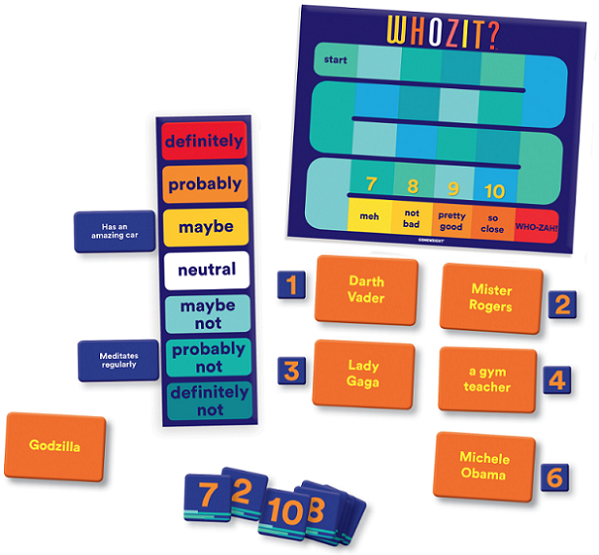Whozit? A Cooperative Party Game of Guess Who and Clue Giving

How likely is Darth Vader to meditate? Do you think Big Bird drives an expensive car? These are the things you’ll have to consider while playing Whozit?.
Gamewright’s new cooperative party game has players trying to guess which of the six characters on the table is the clue giver’s. Eliminate one character at a time as you try to narrow it down!
Gameplay
The score board is placed in the center of the table and a pawn moved to the start location. Next to it, you place the meter board. This has seven spaces (definitely, probably, maybe, neutral, maybe not, probably not, and definitely not). Next you place six tokens numbered one through six on the table, and a player is chosen to be the clue giver for the first round (this role passes to the player on the left each round).
At the start of every round, six new character cards are drawn and one is placed alongside each number token. Characters can be famous people, fictional characters, someone sitting around the table, or something more general such as specific occupations. Character cards are double sided, and players can agree as a team to flip or discard a card if not everyone is familiar enough with the character listed on it.
The clue giver then shuffles the number cards and draws one. This tells him which of the six characters is his character for the round. Next he draws two clue cards. Every clue card is double sided — the clue giver checks both sides and chooses which sides he wishes to use. Clues are various features or descriptors, such as ‘would handwrite a thank-you note’ or ‘drives an expensive car’. The clue giver then places the clue cards along the meter board, on the spaces to indicate how well these attributes describe his character. For example, if your character were Batman, you would place ‘drives an expensive car’ on the ‘definitely’ meter space, while ‘would handwrite a thank-you note’ might go on the ‘probably not’ space.
Once the clues have been placed, the other players discuss the clues to determine which characters fit or do not fit the clue cards. One at a time, they discard one of the characters from the table that they believe is not the clue giver’s character. For each card they correctly discard, the clue giver moves the pawn up one space on the score board. The round ends when only the clue giver’s character remains on the table, or the players accidently discard that character.
During the sixth and final round, players must draw extra character cards based on how far behind on the score board their pawn is. The farther back you are, the more character cards you have to draw, making the last round the most difficult. Players then calculate their score based on the pawn’s final position at the end of the last round.

Review
Whozit? is an easy-to-teach party game that’s also simple to adapt to your crowd. Don’t know who a character is? Discard it! Have someone playing who is not up on a lot of popular fiction characters? You can use the more generalized occupation cards or real people.
Each round has a great build up as you slowly remove one character at a time. Both roles are enjoyable; whether you are working to guess what the clue giver was thinking, or sitting back and listening to your teammates talk about the clues you gave.
The range on the meter board also leads to some fun moments of debate or leaps of logic. The clue giver has to think outside the box but also try to predict how her teammates are likely to read each clue. This makes the game more challenging and adds humor value as you consider the various questions that pop up during the game (could Cleopatra cook without a recipe? And is she likely to do it more or less often than a janitor?).
Aesthetically, the game isn’t very exciting. The components are all well made, and sturdy, but there’s just nothing really fun about the way it looks and some of the color choices are a little dull. Gamewright has set the bar high with its usual production value, so this is a little disappointing.
The scoring system is also problematic. When you reach the final round, you are supposed to move the pawn up to a certain point on the score board if you have not already reached it. This makes the earlier rounds feel a little pointless, and still leaves you feeling unsatisfied even if you pull off a fantastic final round performance and reach the final space on the board. However, the extra characters for the final round is a fun mechanic and a great way to raise the stakes.
Whozit? makes for a fantastic party game because it encourages conversation that can be thoroughly enjoyed whether you’re playing with close friends or people you’ve just met.
Pros: Creates fun discussions, good build up each round, wide range of character cards
Cons: Not aesthetically exciting, scoring system is flawed
Disclosure: we received a complimentary review copy of this game.







